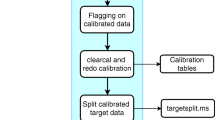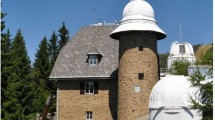Abstract
Curvit is an open-source Python package that facilitates the creation of light curves from the data collected by the Ultra-Violet Imaging Telescope (UVIT) onboard AstroSat, India’s first multi-wavelength astronomical satellite. The input to Curvit is the calibrated events list generated by the UVIT-Payload Operation Center (UVIT-POC) and made available to the principal investigators through the Indian Space Science Data Center. The features of Curvit include: (i) automatically detecting sources and generating light curves for all the detected sources and (ii) custom generation of light curve for any particular source of interest. We present here the capabilities of Curvit and demonstrate its usability on the UVIT observations of the intermediate polar FO Aqr as an example. Curvit is publicly available on GitHub at https://github.com/prajwel/curvit.





Similar content being viewed by others
Change history
06 June 2021
The original article was revised to correct the hyperlink in the Abstract section
References
Agrawal P. 2006, A broad spectral band Indian Astronomy satellite ‘Astrosat’, Advances in Space Research, 38, 2989, Spectra and Timing of Compact X-ray Binaries
Astropy Collaboration: Robitaille T. P., Tollerud E. J. et al. 2013, Astropy: A community Python package for astronomy, A&A, 558, A33
Astropy Collaboration: Price-Whelan A. M., SipHocz B. M. et al. 2018, The Astropy Project: Building an Open-science Project and Status of the v2.0 Core Package, Astron. J., 156, 123
Bradley L., Sipőcz B., Robitaille T. et al. 2020, astropy/photutils: 1.0.1, https://doi.org/10.5281/zenodo.4049061
Harris C. R., Millman K. J., van der Walt S. J. et al. 2020, Nature, 585, 357362
Hunter J. D. 2007, Matplotlib: A 2D graphics environment, Computing in Science & Engineering, 9, 90
Hutchings J. B., Postma J., Asquin D., Leahy D. 2007, PASP, 119, 1152
Maneewongvatana S., Mount D. M. 1999, in Center for Geometric Computing 4th Annual Workshop on Computational Geometry, vol. 2, 1–8
Million C., Fleming S. W., Shiao B., Seibert M., Loyd P., Tucker M., Smith M., Thompson R., White R. L. 2016, Astrophys. J., 833, 292
Postma J., Hutchings J. B., Leahy D. 2011, PASP, 123, 833
Postma J. E., Leahy D. 2017, PASP, 129, 115002
Rani P., Stalin C., Goswami, K. D. 2019, MNRAS, 484, 5113
Stetson P. B. 1987, PASP, 99, 191
Tandon S., Stalin C., Subramaniam A., Ghosh S., Hutchings, J. 2017a, Curr. Sci., 113, 583
Tandon S. N., Subramaniam A., Girish V. et al. 2017b, Astron. J., 154, 128
Tandon S. N., Hutchings J. B., Ghosh S. K. et al. 2017c, J. Astrophys. Astron., 38, 28
Tandon S. N., Postma J., Joseph P. et al. 2020, Astron. J., 159, 158
Virtanen P., Gommers R., Oliphant T. E. et al. 2020, Nature Methods, 17, 261
Acknowledgements
This publication uses the data from the AstroSat mission of the Indian Space Research Organisation (ISRO), archived at the Indian Space Science Data Centre (ISSDC). This publication uses UVIT data processed by the payload operations centre at IIA. The UVIT is built in collaboration between IIA, IUCAA, TIFR, ISRO and CSA.
Author information
Authors and Affiliations
Corresponding author
Additional information
The original article was revised to correct the hyperlink in the Abstract section.
This article is part of the Special Issue on “AstroSat: Five Years in Orbit”.
Appendices
Appendices
Appendix A. To estimate the number of bins
To calculate the number of bins, the very first and last values of the original-time array is taken to estimate the width of the time array. Then, the time array width is divided by the bin width, and integer part of the resultant value is taken as the number of bins.
Appendix B. Missing frame correction
Assume that an ideal non-variable source has a flux of 0.1 CPF (or \(\sim \)2.87 CPS for \(512\times 512\) mode). If the bin width were set to 1 second, then the subset-time histogram would be as follows:
\([2.87, 2.87, 2.87, 2.87, 2.87, 2.87,\ldots].\)
However, if some of the frames vis-a-vis rows are missing from events list FITS table, we might get an array as given below:
\([2.87, 2.53, 1.01, 2.84, 1.94, 2.87,\ldots].\)
A false variability can be inferred from the above array. To overcome this, the original-time histogram is used. The missing frames will be reflected as a reduced number of events per bin in original-time histogram. For the case above, the original-time histogram would be as follows:
\([28.7, 25.3, 10.1, 28.4, 19.4, 28.7,\ldots].\)
By taking the ratio of two histograms, the real light curve in CPF is obtained as follows:
\([0.1, 0.1, 0.1, 0.1, 0.1, 0.1,\ldots].\)
CPF is then converted to CPS by multiplying with the frame-rate (\(\sim \)28.7 for \(512\times 512\) mode).
Rights and permissions
About this article
Cite this article
Joseph, P., Stalin, C.S., Tandon, S.N. et al. Curvit: An open-source Python package to generate light curves from UVIT data. J Astrophys Astron 42, 25 (2021). https://doi.org/10.1007/s12036-020-09680-5
Received:
Accepted:
Published:
DOI: https://doi.org/10.1007/s12036-020-09680-5




